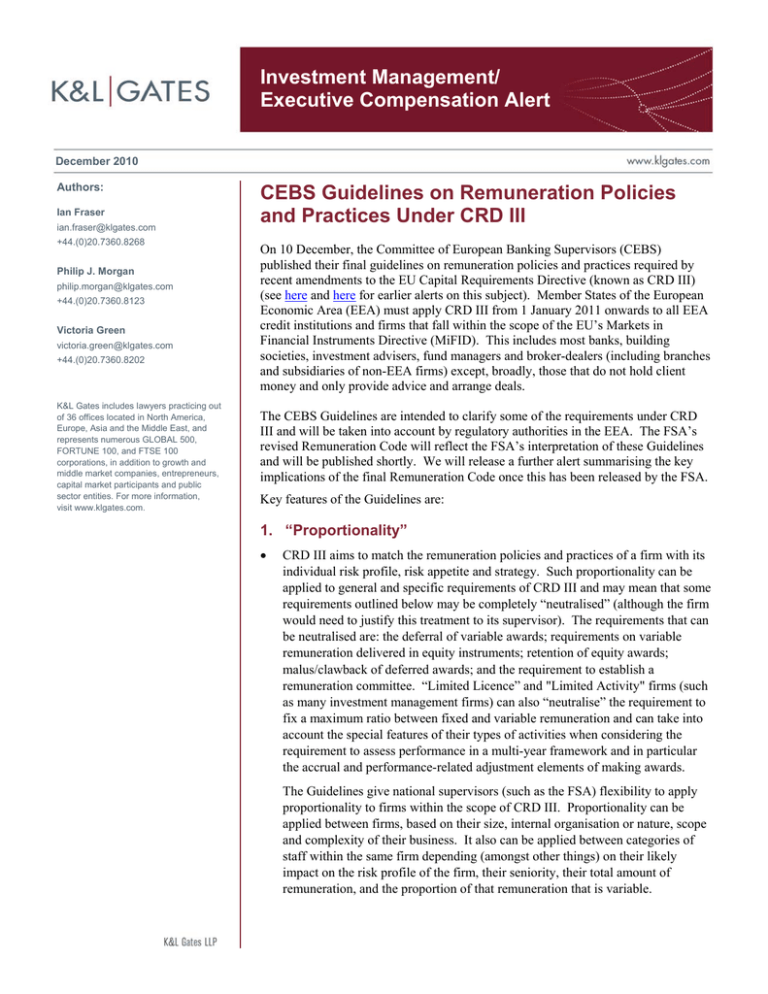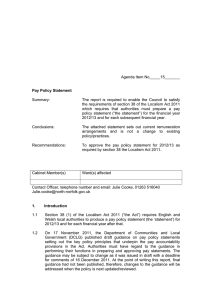
Investment Management/
Executive Compensation Alert
December 2010
Authors:
Ian Fraser
ian.fraser@klgates.com
+44.(0)20.7360.8268
Philip J. Morgan
philip.morgan@klgates.com
+44.(0)20.7360.8123
Victoria Green
victoria.green@klgates.com
+44.(0)20.7360.8202
K&L Gates includes lawyers practicing out
of 36 offices located in North America,
Europe, Asia and the Middle East, and
represents numerous GLOBAL 500,
FORTUNE 100, and FTSE 100
corporations, in addition to growth and
middle market companies, entrepreneurs,
capital market participants and public
sector entities. For more information,
visit www.klgates.com.
CEBS Guidelines on Remuneration Policies
and Practices Under CRD III
On 10 December, the Committee of European Banking Supervisors (CEBS)
published their final guidelines on remuneration policies and practices required by
recent amendments to the EU Capital Requirements Directive (known as CRD III)
(see here and here for earlier alerts on this subject). Member States of the European
Economic Area (EEA) must apply CRD III from 1 January 2011 onwards to all EEA
credit institutions and firms that fall within the scope of the EU’s Markets in
Financial Instruments Directive (MiFID). This includes most banks, building
societies, investment advisers, fund managers and broker-dealers (including branches
and subsidiaries of non-EEA firms) except, broadly, those that do not hold client
money and only provide advice and arrange deals.
The CEBS Guidelines are intended to clarify some of the requirements under CRD
III and will be taken into account by regulatory authorities in the EEA. The FSA’s
revised Remuneration Code will reflect the FSA’s interpretation of these Guidelines
and will be published shortly. We will release a further alert summarising the key
implications of the final Remuneration Code once this has been released by the FSA.
Key features of the Guidelines are:
1. “Proportionality”
•
CRD III aims to match the remuneration policies and practices of a firm with its
individual risk profile, risk appetite and strategy. Such proportionality can be
applied to general and specific requirements of CRD III and may mean that some
requirements outlined below may be completely “neutralised” (although the firm
would need to justify this treatment to its supervisor). The requirements that can
be neutralised are: the deferral of variable awards; requirements on variable
remuneration delivered in equity instruments; retention of equity awards;
malus/clawback of deferred awards; and the requirement to establish a
remuneration committee. “Limited Licence” and "Limited Activity" firms (such
as many investment management firms) can also “neutralise” the requirement to
fix a maximum ratio between fixed and variable remuneration and can take into
account the special features of their types of activities when considering the
requirement to assess performance in a multi-year framework and in particular
the accrual and performance-related adjustment elements of making awards.
The Guidelines give national supervisors (such as the FSA) flexibility to apply
proportionality to firms within the scope of CRD III. Proportionality can be
applied between firms, based on their size, internal organisation or nature, scope
and complexity of their business. It also can be applied between categories of
staff within the same firm depending (amongst other things) on their likely
impact on the risk profile of the firm, their seniority, their total amount of
remuneration, and the proportion of that remuneration that is variable.
Investment Management/Executive Compensation Alert
•
The Guidelines state that “Limited Licence” and
“Limited Activity” firms should be subject to a
more proportionate regime as they typically
have a lower prudential risk profile.
Note: “Limited Licence” firms are, broadly, firms
other than banks that are not authorised to deal on
their own account or underwrite or place financial
instruments on a firm commitment basis. “Limited
Activity” firms are, broadly, firms other than banks
that have a base capital requirement of €730,000 and
either (a) deal on their own accounts only to execute
client orders or to gain access to a clearing system
when acting as agent or (b) do not hold client money
or securities, do not provide investment services
other than dealing on their own accounts, have no
external customers for their investment services, and
whose transactions are guaranteed by a clearing
institution.
•
4. Remuneration Design
The following principles only apply to Identified
Staff:
•
Explicit maximum ratios of fixed/variable
compensation must be set, although these may
vary between firms and between staff at the
firm depending on job description and seniority.
•
Between 40% to 60% of variable remuneration
must be deferred for at least three to five years,
depending on the impact the staff member has
on the risk profile of the firm. For senior
management, the firm should consider longer
deferral periods. The variable remuneration can
vest on a pro rata basis, but not more frequent
than annually, and vesting cannot start earlier
than one year after the date at which
performance is measured to determine the
amount of the award.
•
At least 50% of variable remuneration must be
delivered in shares or share-linked instruments
and must be applied equally to the upfront and
deferred part of awards. Share-linked
instruments are instruments whose value is
based on an increase in the market value of the
underlying stock and have the share price as a
reference point (e.g. stock appreciation rights
(SARs) and phantom options). They should not
carry a right to dividends or dividend
equivalents until vesting. It appears, however,
that deferred cash can attract market value rates
of interest even if unvested. The Guidelines
also refer to other “non-cash instruments” that
reflect the credit quality of the firm. For
example, a firm can pay part of the variable
remuneration through its own managed funds,
and these will be considered as an appropriate
non-cash instrument, provided the overall risk
2. Scope: Groups
•
CRD III applies to EEA parent firms and all
branches and subsidiaries of those firms whether
located in the EEA or otherwise. In respect of
non-EEA parented groups, it applies to
subsidiaries or branches operating in the EEA
and any subsidiaries or branches of those
entities whether located in the EEA or
otherwise.
3. Scope: Individuals
•
The general principles of the Guidelines and
CRD III apply to all staff working at an in-scope
firm/group.
•
Specific provisions on remuneration policies
apply only to “Identified Staff”, which includes
senior management, risk takers, staff controlling
independent control functions (i.e. compliance,
risk management, HR, internal audit etc) and
any employee receiving total remuneration that
takes him or her into the same remuneration
bracket as senior management and risk takers,
whose professional activities have a material
impact on the firm’s risk profile. Only
individuals who have a material impact on the
firm’s risk profile are included as “Identified
Staff”; simply being highly paid does not in
itself mean that someone is Identified Staff.
Limited partners and general partners of limited
partnerships and individual proprietors may be
caught by CRD III, subject to proportionality,
but distributions that partners receive as owners
of a firm are not covered by the Guidelines,
unless they are designed to circumvent the
Guidelines.
December 2010
2
Investment Management/Executive Compensation Alert
alignment structure of the remuneration
corresponds to the CRD III principles.
•
•
Any portion of variable remuneration delivered
in equity must be subject to a further retention
period that is proportional to the firm's situation.
The Guidelines indicate that (i) if the deferral
period is more than five years, a shorter
retention period may be reasonable; (ii) it may
be appropriate for staff with the most material
impact on the risk profile of the firm to have
longer retention periods; and (iii) for the most
senior staff, large firms should consider a
retention period for upfront awards that goes
beyond the deferral period for the deferred
awards.
Example: An Identified Staff individual is
awarded £100 variable remuneration. He has a
deferral percentage of 60% and an equity ratio
of 50%. He will receive:
o
o
•
•
£40 upfront of which:
£20 will be in cash; and
£20 will be in shares or sharelinked instruments, subject to
retention requirements; and
first year of service. Multi-year guarantees are
prohibited. Retention awards are considered to
be a form of variable compensation and are
only permitted where risk alignment
requirements are properly applied.
•
Enhanced discretionary pension benefits (i.e.
one-off payments, not standard pension plan
contributions) must take the form of shares or
share-linked instruments. In the context of
retirement, vested benefits should be subject to
retention for at least five years. In the context
of termination prior to retirement, benefits
should not be vested before a period of five
years, and should be subject to performance
adjustments and malus/clawback.
•
Severance payments are not prohibited but must
be related to performance over time and must
not reward failure.
5. Disclosure
•
Firms within the scope of CRD III will be
required to make, at least annually, general and
specific public disclosures regarding their
remuneration policies and practices and the
decision-making process, as well as information
on how pay and performance are linked.
Aggregate quantitative information on
remuneration must be provided, broken down
by (i) business area and (ii) senior management
and members of staff whose actions have a
material impact on the firm's risk profile.
•
Disclosure is subject to proportionality in
respect of the type and amount of information
disclosed. Small or non-complex institutions
will only be expected to provide some
qualitative and very basic quantitative
information where appropriate. Firms should
disclose how they have applied proportionality
and what parts of the disclosure requirements
have been “neutralised”.
•
The disclosure must be easily accessible to the
public. The remuneration policy must also be
accessible by all staff members of a firm.
£60 deferred of which:
£30 will be in deferred cash subject
to vesting; and
£30 will be in deferred shares or
share-linked instruments, subject to
vesting and to retention
requirements following vesting.
Awards should be subject to “malus”
performance adjustments which can be used to
prevent vesting of all or part of the deferred
payments, and “clawback” provisions, under
which staff would return previously vested
awards in the case of established fraud or
misleading information, or where remuneration
is received in breach of CRD III and the
Guidelines. The equity portion of awards that is
paid upfront is fully vested and not subject to
“malus” adjustments.
Guaranteed bonuses can only be offered in
exceptional circumstances to new hires for the
December 2010
3
Investment Management/Executive Compensation Alert
6. Timing
•
CRD III comes into force on 1 January 2011,
and there are no transitional provisions under
the Directive. CEBS does not have the power to
delay implementation of CRD III, but does
recognise that some CRD III requirements, such
as amending existing contracts, may take time.
The FSA may, therefore, be able to operate a
transitional period as proposed in its
consultation paper on revising the
Remuneration Code.
Anchorage Austin Beijing Berlin Boston Charlotte Chicago Dallas Dubai Fort Worth Frankfurt Harrisburg Hong Kong London
Los Angeles Miami Moscow Newark New York Orange County Palo Alto Paris Pittsburgh Portland Raleigh Research Triangle Park
San Diego San Francisco Seattle Shanghai Singapore Spokane/Coeur d’Alene Taipei Tokyo Warsaw
Washington, D.C.
K&L Gates includes lawyers practicing out of 36 offices located in North America, Europe, Asia and the Middle East, and represents numerous
GLOBAL 500, FORTUNE 100, and FTSE 100 corporations, in addition to growth and middle market companies, entrepreneurs, capital market
participants and public sector entities. For more information, visit www.klgates.com.
K&L Gates comprises multiple affiliated entities: a limited liability partnership with the full name K&L Gates LLP qualified in Delaware and
maintaining offices throughout the United States, in Berlin and Frankfurt, Germany, in Beijing (K&L Gates LLP Beijing Representative Office), in
Dubai, U.A.E., in Shanghai (K&L Gates LLP Shanghai Representative Office), in Tokyo, and in Singapore; a limited liability partnership (also named
K&L Gates LLP) incorporated in England and maintaining offices in London and Paris; a Taiwan general partnership (K&L Gates) maintaining an
office in Taipei; a Hong Kong general partnership (K&L Gates, Solicitors) maintaining an office in Hong Kong; a Polish limited partnership (K&L
Gates Jamka sp.k.) maintaining an office in Warsaw; and a Delaware limited liability company (K&L Gates Holdings, LLC) maintaining an office in
Moscow. K&L Gates maintains appropriate registrations in the jurisdictions in which its offices are located. A list of the partners or members in each
entity is available for inspection at any K&L Gates office.
This publication is for informational purposes and does not contain or convey legal advice. The information herein should not be used or relied upon
in regard to any particular facts or circumstances without first consulting a lawyer.
©2010 K&L Gates LLP. All Rights Reserved.
December 2010
4





